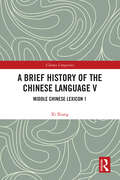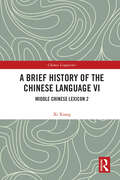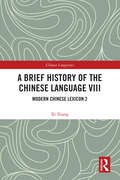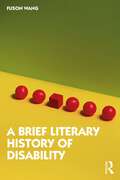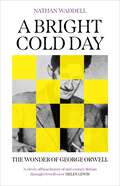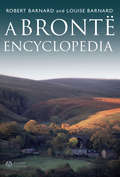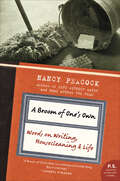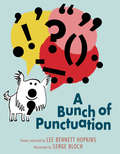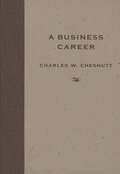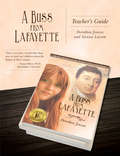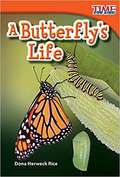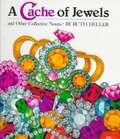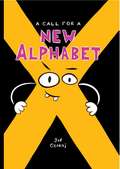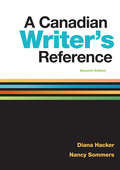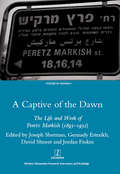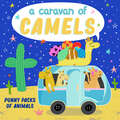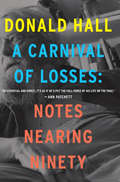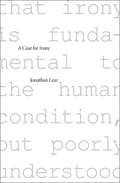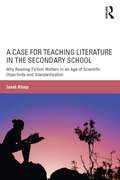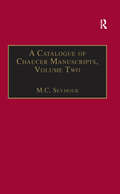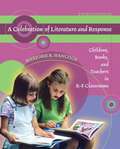- Table View
- List View
A Brief History of the Chinese Language V: Middle Chinese Lexicon 1 (Chinese Linguistics)
by Xi XiangAs the fifth volume of a multi-volume set on the Chinese language, this book studies the development of monosyllables and polysyllables in Middle Chinese and the overall evolution of lexical meanings during the period.Focusing on lexicons in Middle Chinese, the Chinese language used between the 4th century AD and the 12th century AD, the book first introduces the monosyllabic neologisms of Middle Chinese, including characters and words derived from Old Chinese lexicons and those newly created. It then examines the development of polysyllabic words in Middle Chinese, ranging from single morpheme words, tautologies and compound words. The final chapter discusses the changes and extension of word meanings in medieval Chinese.Illustrated with abundant examples, this comprehensive groundwork on Chinese lexical history will be a must read for scholars and students studying ancient Chinese language, linguistics and especially for beginning learners of the Middle Chinese lexicon.
A Brief History of the Chinese Language VI: Middle Chinese Lexicon 2 (Chinese Linguistics)
by Xi XiangAs the sixth volume of a multi-volume set on the Chinese language, this book studies the influence of foreign culture on Middle Chinese lexicon and the development of synonyms, idioms and proverbs during the period.Focusing on lexicons in Middle Chinese, the middle form of the Chinese language used between the 4th century AD and the 12th century AD, this book first analyzes loanwords in Middle Chinese, a product of cultural exchange with western regions on the silk road and the impact of Buddhism. It then discusses the differences in meaning between monosyllables and polysyllables. The final chapter describes enriching idioms and proverbs and the major sources of words, including classical works, Buddhist texts and the spoken language.Illustrated with abundant examples, this comprehensive groundwork on Chinese lexical history will be a must read for scholars and students studying ancient Chinese language, linguistics and especially for beginning learners of the Middle Chinese lexicon.
A Brief History of the Chinese Language VIII: Modern Chinese Lexicon 2 (Chinese Linguistics)
by Xi XiangAs the final volume of a multi-volume set on the Chinese language, this book studies the Western and Japanese influence on the lexicon of Modern Chinese, lexical developments in synonyms, idioms and proverbs in modern times, and lexical developments in contemporary times.This volume first introduces the influence of foreign cultures on the modern Chinese lexicon with an emphasis on loanwords from Japanese and Indo-European languages. It then discusses the synonyms, idioms and proverbs of Modern Chinese, elucidating their evolution, sources and composition. The final part centers on the development of the Chinese lexicon after the May 4 Movement in 1919, marking the beginning of the contemporary phase of the Chinese language. The author analyses trends and types of neologisms and loanwords and analyzes the blend of Mandarin and dialect words as well as the necessity of lexical standardization.Illustrated with abundant examples, this comprehensive groundwork on Chinese lexical history will be a must read for scholars and students studying modern Chinese language, linguistics and especially for beginning learners of modern and contemporary Chinese lexicon.
A Brief Literary History of Disability
by Fuson WangA Brief Literary History of Disability is a convenient, lucid, and accessible entry point into the rapidly evolving conversation around disability in literary studies. The book follows a chronological structure and each chapter pairs a well-known literary text with a foundational disability theorist in order to develop a simultaneous understanding of literary history and disability theory. The book as a whole, and each chapter, addresses three key questions: • Why do we even need a literary history of disability? • What counts as the literature of disability? • Should we even talk about a literary aesthetic of disability? This book is the ideal starting point for anyone wanting to add some disability studies to their literature teaching in any period, and for any students approaching the study of literature and disability. It is also an efficient reference point for scholars looking to include disability studies approaches in their research.
A Bright Cold Day: The Wonder of George Orwell
by Nathan WaddellA pioneering biography of George Orwell told through moments of everyday life 'A clever, offbeat history of mid-century Britain through George Orwell&’s eyes.' Helen Lewis When we think about Orwell, we imagine an angular, moustachioed sceptic crouched over a typewriter, who – between puffs on his cigarette – composes effortless streams of prose, unadorned but explosive. We see a man with &‘Important Things to Say&’ about: the slow creep of authoritarianism; the consequences of all-seeing tech; the fragility of truth. Much less often do we see him as a person caught up in the business of everyday life. And yet Orwell&’s work thrums with the quotidian: the smell of boiled cabbage, the chill of an unheated flat in early spring, the rumbling of old pipes. A Bright Cold Day reveals how the principles that govern us begin in the mundane. From waking and showering to breakfast, work, lunch, the pub, sleep and dreaming, Orwell was never dulled to the routines of living. And in the details of the day, we can understand how power, money, freedom and choice play out, not just for Orwell&’s literary characters, but for us all. *** 'An astute and intimate portrait of George Orwell.' Dorian Lynskey, author of The Ministry of Truth 'Beautifully written... urgent and compelling.' Emma Smith, author of Portable Magic
A Bronte Encyclopedia
by Robert Barnard Louise BarnardA Brontë Encyclopedia is an A- Z encyclopedia of the most notable literary family of the 19th century highlighting original literary insights and the significant people and places that influenced the Brontës' lives.Comprises approximately 2,000 alphabetically arranged entriesDefines and describes the Brontës' fictional characters and settingsIncorporates original literary judgements and analyses of characters and motivesIncludes coverage of Charlotte's unfinished novels and her and Branwell's juvenile writingsFeatures over 60 illustrations
A Broom of One's Own: Words on Writing, Housecleaning & Life (P. S. Series)
by Nancy PeacockFor the twice-published novelist, reading an article about herself in the National Enquirer—under the headline "Here's One for the Books: Cleaning Lady Is an Acclaimed Author"—was more than a shock. It was an inspiration.In A Broom of One's Own, Nancy Peacock, whose first novel was selected by the New York Times as a Notable Book of the Year, explores with warmth, wit, and candor what it means to be a writer. An encouragement to all hard-working artists, no matter how they make a living, Peacock's book provides valuable insights and advice on motivation, craft, and criticism while offering hilarious anecdotes about the houses she cleans.
A Bunch of Punctuation
by Lee Bennett HopkinsSelected by noted anthologist Lee Bennett Hopkins, this collection of all-new poems is written from the points of view of personality-filled punctuation marks, and is a memorable introduction to grammar for kids (adults, too!)In this land of punctuation, the exclamation mark is a superhero who tells a story chock-full of bops and bams, the comma lets you pause to enjoy the weather, and the period is where you must come to a full stop--or else the Grammar Police will get you. With humor and imagination, A Bunch of Punctuation makes it easy to remember the jobs of the various punctuation marks. Award-winning poet and anthologist Lee Bennett Hopkins has compiled a unique collection of poems featuring brand-new works by well-known poets, accompanied by inventive artwork by illustrator Serge Bloch.
A Burst of Light
by Audre LordeIn 1984, feminist poet Lorde learned that her breast cancer had metastasized to the liver. The moving title section comprises a series of journal excerpts that both frighten and inspire: choosing not to have a biopsy, she instead treats the disease with a stay at the homeopathic Lukas Klinik in Switzerland, consultations with more traditional medical specialists and alternatives like self-hypnosis. Her lifelong battle against racism, sexism and homophobia has armed her with the resilience to resist cancer, and thus "A Burst of Light" becomes not only a chronicle of Lorde's fight against disease, but a view of one woman's sparring with injustice, whether the oppressors are the South African police, the American government or malignant cells within her own body. Although it rings out with passion, anger and hope, the lengthy title piece is sometimes rambling and repetitive. In refreshing contrast, three outstanding essays on black lesbianism, the parallels between South Africa and the United States, and lesbian parenting are politically specific and pithy. -Publishers Weekly
A Business Career
by Charles W. ChesnuttNever before published, A Business Career is the story of Stella Merwin, a white woman entering the working-class world to discover the truth behind her upper-class father's financial failure. A “New Woman” of the 1890s, Stella joins a stenographer's office and uncovers a life-altering secret that allows her to regain her status and wealth. When Charles W. Chesnutt died in 1932, he left behind six manuscripts unpublished, A Business Career among them. Along with novels of Paul Laurence Dunbar, it is one of the first written by an African American who crosses the color line to write about the white world. It is also one of only two Chesnutt novels with a female protagonist. Rejecting the novel for publication, Houghton Mifflin editor Walter Hines Page encouraged Chesnutt to try to get the book in print. “You will doubtless be able to find a publisher, and my advice to you is decidedly to keep trying till you do find one,” he wrote. Page clearly saw that in A Business Career Chesnutt had written a successful popular novel grounded in realism but one that exploits elements of romance.
A Buss From Lafayette Teacher's Guide
by Dorothea Jensen Sienna LarsonThis guide is for A Buss From Lafayette, Dorothea Jensen's award-winning (Literary Classics, Purple Dragonfly, eLit Awards, etc.) historical novel for young readers. This guide contains bulletin board ideas, vocabulary exercises, varied student handouts, puzzles, games, reading comprehension quizzes, discussion questions, and both individual and class projects. Its cross-curricular activities include language arts/reading, social studies, mathematics, health/safety, art, music, dance, drama, recipes, and suggestions for real and virtual field trips. A full answer key is provided. The main topics covered are the American Revolution, Lafayette's role in our War of Independence, Lafayette's Farewell Tour of America in 1824-5, and everyday life and customs in rural America in the 1820s.
A Butterfly's Life
by Dona Herweck RiceIn this engaging nonfiction book, early readers are introduced to the life cycle of a butterfly. The book explains the different stages of a butterfly's life from the stage of eggs to a colourful butterfly.
A Cache of Jewels and Other Collective Nouns
by Ruth HellerRhyming text and illustrations introduce a variety of collective nouns such as a "drift of swans" and a "clutch of eggs."
A Call for a New Alphabet
by Jef CzekajX is tired of being at the back of every alphabet book. X is tired on being under-used. Exasperated, X calls for a change in alphabetical order. But after a crazy dream in which he learns some exceptional English grammar rules, X decides he likes his alphabetical placement after all. A hybrid of picture book and graphic novel, A Call for a New Alphabet humorously introduces readers to the concepts of plural words, sigh words, silent letters, and other idiosyncrasies of the English language.
A Canadian Writer’s Reference: Platinum Edition
by Diana Hacker Nancy SommersA Hacker handbook has always been a how-to manual for building confidence as a college writer. Diana Hacker conceived A Writer’s Reference as a quick-access innovation in handbook format, and Nancy Sommers continues to reinvent its content for an evolving course emphasizing critical reading and writing. For more than 20 years, the book has allowed students to build confidence and take ownership of their college writing experience. <P><P> A Canadian Writer’s Reference, and a variety of exciting digital options together represent a next-level tool for college writers. What’s most exciting? An emphasis on help that is personal, practical, and digital. A Canadian Writer’s Reference is reimagined as a system that helps students target their needs and see their successes; that offers innovative practice with writing, reading, thinking, and research; and that lives in an engaging multimedia environment.
A Captive of the Dawn: The Life and Work of Peretz Markish (1895-1952)
by Joseph ShermanPeretz Markish (1895-1952), one of Eastern Europe's most important Yiddish poets in the period between the two world wars, was a fiercely independent maverick who published work in all literary genres. Although emerging from the Kiev literary tradition, Markish always went his own way in a literary career spanning four decades and embracing almost
A Caravan of Camels
by Christopher RobbinsDid you know elephants have parades, camels have caravans, and porcupines have prickles? From a shoal of aardvarks to a zeal of zebras, kids can learn the names of animal groups in this adorable padded board book. With bright, trendy illustrations and plenty of hidden puns, A Caravan of Camels showcases punny animal families of all kinds from A to Z. Whether it’s a smack, a barrel, or a zeal, it's a family!
A Career in Radio: Understanding the Key Building Blocks
by Sayed Mohammad AmirThis book gives an overview of the development, significance, and impact of radio as a medium of mass communication in modern society. It provides a thorough understanding of the various wings and functionaries of the radio industry. The book also covers aspects of commercial radio, the basics of understanding the pulse of radio listeners, formatting radio programming, making an effective sales pitch and producing great commercials to exhaustive advice on presenting a show, appearing for interviews, and public speaking. It also gives insight into the changes brought in by technology in terms of traditional radio broadcasts, such as digital radio, highlighting its advancements in audio quality and the diversity of programming options available, and satellite radio, subscription-based services, and exclusive access to specialised programming. An outcome of the author’s vast experience of working as a radio jockey and programme manager for over 17 years, his book will be an ideal textbook for undergraduate and postgraduate students of journalism and mass communication, taking courses on radio, audio and podcasting, media production and digital media. Additionally, this book will be an invaluable companion to existing radio professionals as a resource-book for their professional development.
A Carnival of Losses: Notes Nearing Ninety
by Donald HallNew essays from the vantage point of very old age, once again “alternately lyrical and laugh-out-loud funny,”* from the former poet laureate of the United States * New York Times Donald Hall lived a remarkable life of letters, one capped most recently by the New York Times bestseller Essays After Eighty, a “treasure” of a book in which he “balance[s] frankness about losses with humor and gratitude” (Washington Post). Before his passing in 2018, nearing ninety, Hall delivered this new collection of self-knowing, fierce, and funny essays on aging, the pleasures of solitude, and the sometimes astonishing freedoms arising from both. He intersperses memories of exuberant days—as in Paris, 1951, with a French girl memorably inclined to say, “I couldn’t care less”—with writing, visceral and hilarious, on what he has called the “unknown, unanticipated galaxy” of extreme old age. “Why should a nonagenarian hold anything back?” Hall answers his own question by revealing several vivid instances of “the worst thing I ever did," and through equally uncensored tales of literary friendships spanning decades, with James Wright, Richard Wilbur, Seamus Heaney, and other luminaries. Cementing his place alongside Roger Angell and Joan Didion as a generous and profound chronicler of loss, Hall returns to the death of his beloved wife, Jane Kenyon, in an essay as original and searing as anything he's written in his extraordinary literary lifetime.
A Case for Irony
by Jonathan LearIn 2001, Vanity Fair declared that the Age of Irony was over. Joan Didion has lamented that the United States in the era of Barack Obama has become an "irony-free zone. " Jonathan Lear in his 2006 book Radical Hope looked into Americaâe(tm)s heart to ask how might we dispose ourselves if we came to feel our way of life was coming to an end. Here, he mobilizes a squad of philosophers and a psychoanalyst to once again forge a radical way forward, by arguing that no genuinely human life is possible without irony. Becoming human should not be taken for granted, Lear writes. It is something we accomplish, something we get the hang of, and like Kierkegaard and Plato, Lear claims that irony is one of the essential tools we use to do this. For Lear and the participants in his Socratic dialogue, irony is not about being cool and detached like a player in a Woody Allen film. That, as Johannes Climacus, one of Kierkegaardâe(tm)s pseudonymous authors, puts it, âeoeis something only assistant professors assume. âe Instead, it is a renewed commitment to living seriously, to experiencing every disruption that shakes us out of our habitual ways of tuning out of life, with all its vicissitudes. While many over the centuries have argued differently, Lear claims that our feelings and desires tend toward order, a structure that irony shakes us into seeing. Learâe(tm)s exchanges with his interlocutors strengthen his claims, while his experiences as a practicing psychoanalyst bring an emotionally gripping dimension to what is at stakeâe"the psychic costs and benefits of living with irony.
A Case for Teaching Literature in the Secondary School: Why Reading Fiction Matters in an Age of Scientific Objectivity and Standardization
by Janet AlsupTaking a close look at the forces that affect English education in schools—at the ways literature, cognitive science, the privileging of the STEM disciplines, and current educational policies are connected—this timely book counters with a strong argument for the importance of continuing to teach literature in middle and secondary classrooms. The case is made through critical examination of the ongoing "culture wars" between the humanities and the sciences, recent research in cognitive literary studies demonstrating the power of narrative reading, and an analysis of educational trends that have marginalized literature teaching in the U.S., including standards-based and scripted curricula. The book is distinctive in presenting both a synthesis of arguments for literary study in the middle and high school and sample lesson plans from practicing teachers exemplifying how literature can positively influence adolescents’ intellectual, emotional, and social selves.
A Catalogue of Chaucer Manuscripts: Volume Two: The Canterbury Tales
by M.C. SeymourThis second volume, which completes the first comprehensive catalogue of Chaucer's manuscripts, describes the 56 extant copies and the fragments of 8 otherwise lost copies of the Canterbury Tales. These manuscripts, last examined together over 50 years ago, are here described after a fresh appraisal and in the light of modern scholarship, and some revisions of date, decoration, dialect, location, provenance, and script are suggested. The Introduction defines some of the major textual problems posed by the manuscripts and presents some thoughts thereon, while suggesting solutions to some incidental cruces. The Indices and Appendices record the citation of lost and unidentified copies of the Canterbury Tales, the names of former owners and associates, and addenda et corrigenda for Volume I. The Catalogue is designed as a reference work for those teachers and students who wish to know what and where the extant material is without the labour of its collection and for those able in the various specialities of manuscript bibliography to advance present knowledge.
A Celebration of Ben Jonson
by William F. Blissett Julian Patrick R.W. Van FossenThe papers in this volume were given by some of the world's foremost Jonsonian scholars at a conference at the University of Toronto which marked the 400th anniversary of his birth. Each contributor came from a different institution, and Canada, the United States, Great Britain, and New Zealand were represented. The balance of papers likewise reflects the range of Ben Jonson's achievement and the combination of brio and control so characteristic of him.The papers arrange themselves in pairs: 'The Incredibility of Jonsonian Comedy,' as discussed by Professor Clifford Leech, is of a piece with distrust and defiance of the audience as discussed in the paper 'Jonson and the Loathèd Stage' by Professor Jonas Barish; Professor George Hibbard in 'Ben Jonson and Human Nature' and Professor D.I. McKenzie in 'The Staple of News and the Late Plays' offer critical assessment of plays, the one wide-ranging, the other closely focused on a previously neglected play; and Professor H.N. Maclean in '"A More Secret Cause": The Wit of Jonson's Poetry' and Professor L.C. Knights in 'Ben Jonson: Public Attitudes and Social Poetry' approach the difficult and rewarding task of defining Jonson's poetry of appraisal in different but complementary styles.
A Celebration of Literature and Response: Children, Books, and Teachers in K-8 Classrooms
by Marjorie R. HancockThis engaging book applies reader response theory to children's literature methods to help new and experienced teachers best involve kindergarteners through eighth graders in literature and literacy. Authentic student responses open chapters, book clusters and the accompanying CD database of children's literature provide guidance for involving students with literature, and Literature Resources on the Web guide users to lesson plans, standards, author interviews, projects, and other Internet resources to enrich teaching. For teachers of Children's Literature.
